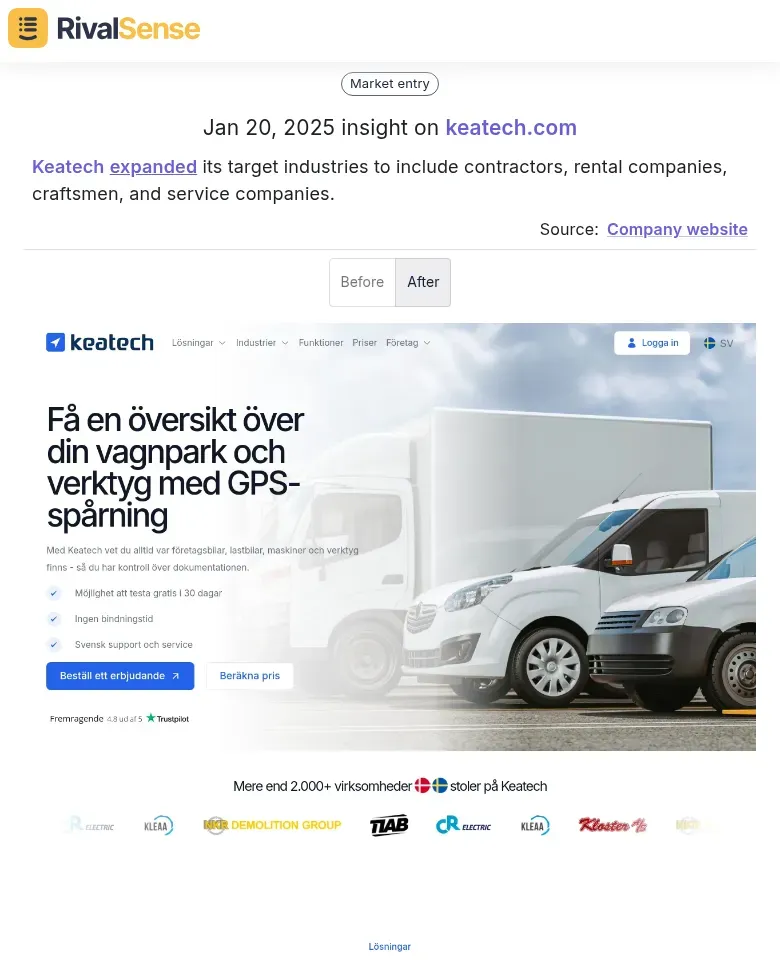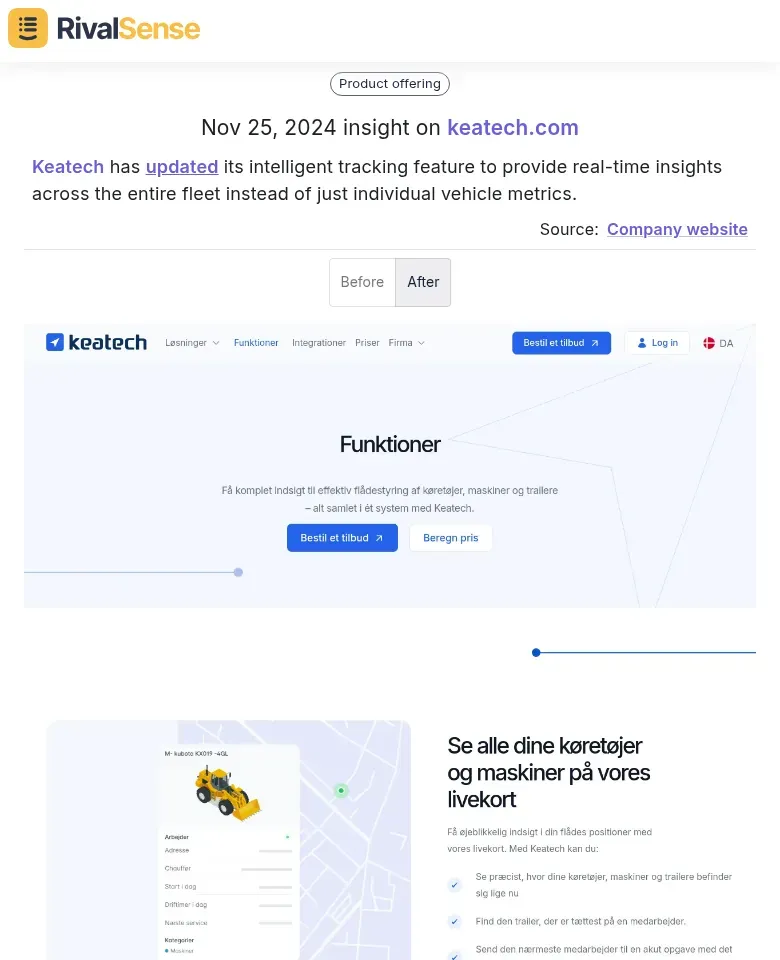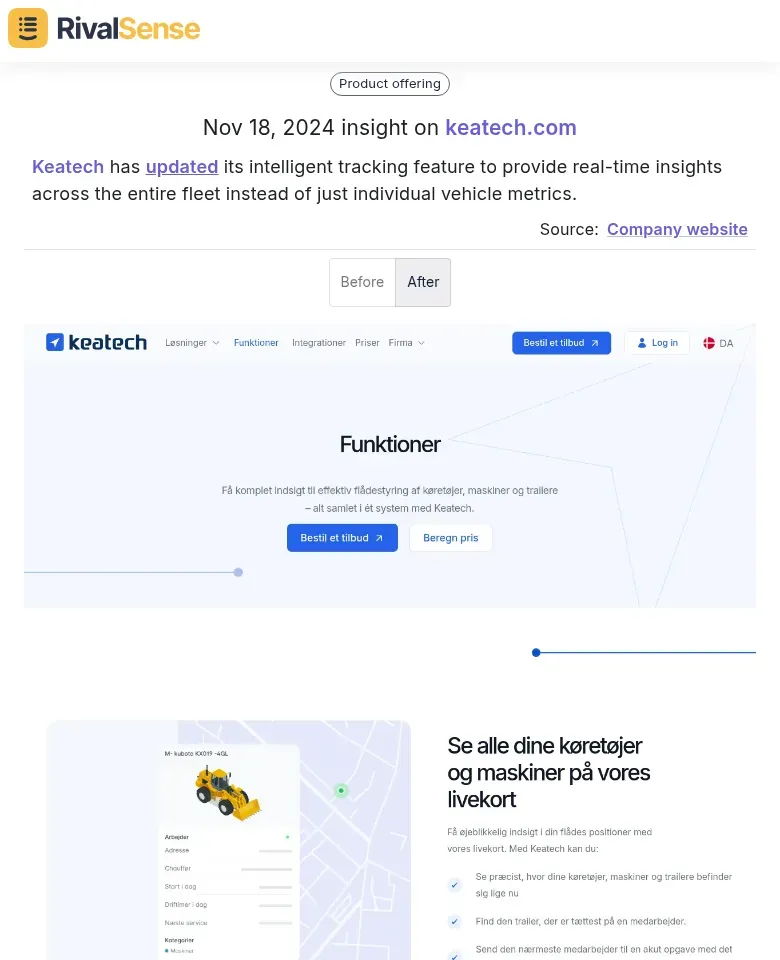Step-by-Step Guide to Competitive Intelligence in Fleet Management
In the fast-evolving fleet management industry, competitive intelligence (CI) is your compass to navigate the competitive landscape. It involves gathering, analyzing, and leveraging data about competitors to make informed strategic decisions. Understanding CI's importance is the first step toward gaining a competitive edge, helping you anticipate market shifts, identify opportunities, and mitigate risks before they impact your operations.
CI drives strategic decisions by providing actionable insights. For instance, analyzing a competitor's pricing strategy can help you adjust your own to attract more clients, while tracking technological advancements can inspire innovations in your fleet. Practical steps to start include:
- Identify Key Competitors: List direct and indirect competitors in your niche
- Gather Data: Use specialized tools to track competitors' pricing, services, and customer feedback
- Analyze Trends: Look for patterns in their strategies to predict future moves
- Implement Insights: Apply findings to refine your offerings and operations
Staying ahead offers benefits like improved customer satisfaction and increased market share. By monitoring competitors' maintenance schedules, you can optimize fleet uptime and reduce costs. 📌 Pro Tip: Regularly update your CI data and involve cross-functional teams for comprehensive analysis.
Identifying Key Competitors and Their Strategies 🔍
Identifying key competitors is foundational for gaining competitive advantage in fleet management. Start by analyzing industry reports and market research to pinpoint leading players. Don't overlook local and niche disruptors who might be reshaping specific market segments through innovative approaches.
Next, examine competitors' target markets, geographic reach, and partnerships. Are they focusing on small businesses, large enterprises, or specific sectors like logistics? Track patterns in their marketing campaigns, pricing models, and technology adoption. For example, heavy investment in electric vehicle fleets might signal shifting market demand.
Monitoring competitors' diversification into new industries provides strategic foresight. Consider this real-world example:
RivalSense detected: Keatech expanded its target industries to include contractors, rental companies, craftsmen, and service companies.
This type of insight reveals growth strategies and emerging market opportunities, allowing you to adjust your own targeting or develop specialized offerings for newly prioritized segments.
✅ Evaluation Checklist:
- List competitors and core services
- Note target markets and customer segments
- Track expansion/diversification efforts
- Identify gaps in their approach
📌 Practical tip: Update competitor analysis quarterly to stay ahead of industry shifts.
Leveraging Technology for Competitive Insights 💻
Modern technology revolutionizes how fleet managers gather competitive intelligence. Automated tools enable efficient data collection and analysis, transforming raw information into actionable strategies. Real-time tracking and analytics provide unprecedented visibility into competitor operations.
Key technological approaches:
- Automated Data Collection: Software that gathers competitor data from websites, social media, and registries reduces manual effort
- Real-Time Tracking: GPS and telematics reveal operational patterns for route optimization
- Fleet-Wide Analytics: Comprehensive benchmarking against competitors highlights improvement areas
Consider this technology-focused insight:
RivalSense detected: Keatech updated its intelligent tracking feature to provide real-time insights across the entire fleet instead of just individual vehicle metrics.
Monitoring such technological upgrades is crucial as they often redefine industry standards and customer expectations, signaling when you need to enhance your own capabilities.
🔧 Implementation Toolkit:
- Maintain updated competitor database (fleet sizes, service areas, pricing)
- Use automated tracking platforms
- Conduct monthly reviews of competitor fleet data
Analyzing Competitors' Product and Service Innovations 🚀
Continuous innovation defines success in fleet management. Systematically tracking competitors' product developments helps you identify feature gaps and anticipate market expectations. This proactive approach ensures your offerings remain competitive and customer-centric.
Effective analysis involves:
- Tracking Updates: Monitor websites, press releases, and social media for feature announcements
- Customer Impact Assessment: Evaluate how innovations address pain points
- Benchmarking: Compare your offerings against industry standards using feature matrices
Product enhancements often reveal strategic priorities, as shown here:
RivalSense detected: Keatech has updated its intelligent tracking feature to provide real-time insights across the entire fleet instead of just individual vehicle metrics.
Tracking such innovations helps benchmark your development roadmap and prioritize features that impact customer retention and acquisition.
📋 Analysis Framework:
- Subscribe to competitors' newsletters
- Use customer feedback tools to gauge reactions
- Conduct quarterly SWOT analyses
- Create feature comparison tables
Implementing Competitive Intelligence Findings 🛠️
Transforming insights into action separates successful fleet operators from the competition. Effective implementation requires aligning findings with business goals and operational capabilities. Start by prioritizing intelligence that addresses your strategic vulnerabilities or expansion opportunities.
Implementation steps:
- Strategic Integration: Align insights with business objectives using SWOT analysis
- Market Adjustment: Adapt targeting based on competitor expansions
- Feature Enhancement: Develop capabilities addressing competitor gaps
| Implementation Area | Action Example |
|---|---|
| Pricing Strategy | Adjust packages after competitor price analysis |
| Service Expansion | Enter markets where competitors show success |
| Technology Adoption | Add predictive features mirroring industry leaders |
🧩 Pro Tips:
- Pilot test new approaches before full implementation
- Involve marketing, operations, and tech teams in strategy sessions
- Create 90-day action plans from intelligence reports
Conclusion and Next Steps 🏁
Mastering competitive intelligence provides sustained advantage in fleet management's dynamic landscape. By systematically tracking competitors' moves, analyzing their strategies, and implementing targeted responses, you position your business for market leadership. Remember that CI is an ongoing process requiring regular refinement as market conditions evolve.
Start your competitive intelligence journey today:
- Identify 3-5 key competitors
- Track their pricing, features, and expansions
- Analyze quarterly trends using SWOT
- Implement at least one strategic adjustment monthly
🔍 Ready to streamline competitor tracking?
Try RivalSense for free to automate competitor monitoring across websites, social media, and registries. Get your first weekly competitor report today—transform market insights into strategic action!
📚 Read more
👉 Leveraging Competitor Insights for Smarter Event Participation
👉 Decoding Geotab's Marketplace Expansion: Strategic Insights & Action Steps
👉 Mastering Market Entry Competitive Analysis: A Strategic Guide for Business Leaders
👉 5 Quick Hacks for Strategic Competitive Monitoring in Legal Compliance



